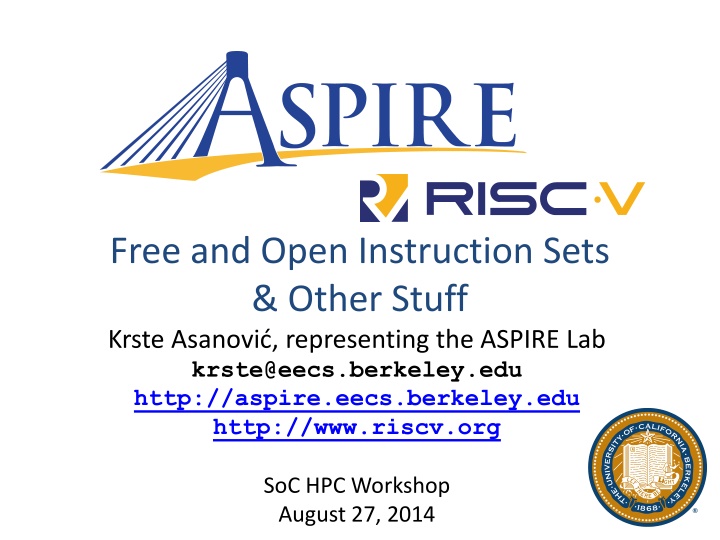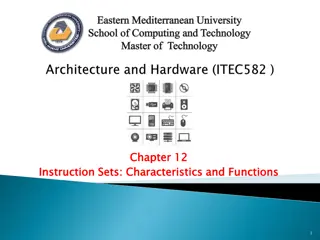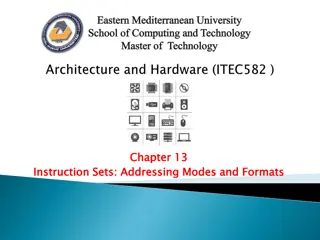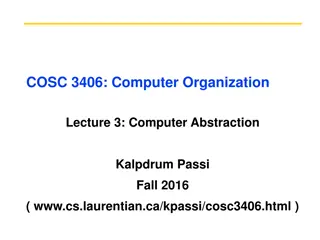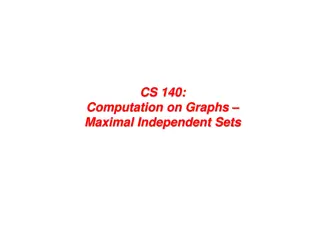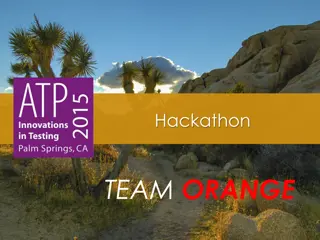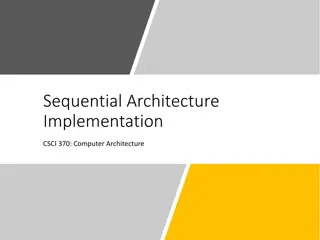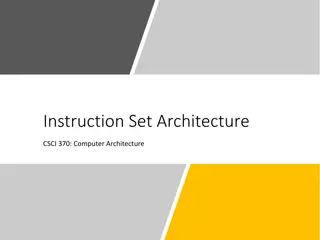The Importance of Free and Open Instruction Sets in the Computer Industry
Explore the significance of free and open instruction sets in the realm of computing, emphasizing the benefits of innovation, market competition, transparency, and affordability in processor design. The discussion delves into the impact of proprietary ISAs, the role of industry standards, and the potential for a more accessible and efficient computing ecosystem.
Download Presentation

Please find below an Image/Link to download the presentation.
The content on the website is provided AS IS for your information and personal use only. It may not be sold, licensed, or shared on other websites without obtaining consent from the author.If you encounter any issues during the download, it is possible that the publisher has removed the file from their server.
You are allowed to download the files provided on this website for personal or commercial use, subject to the condition that they are used lawfully. All files are the property of their respective owners.
The content on the website is provided AS IS for your information and personal use only. It may not be sold, licensed, or shared on other websites without obtaining consent from the author.
E N D
Presentation Transcript
Free and Open Instruction Sets & Other Stuff Krste Asanovi , representing the ASPIRE Lab krste@eecs.berkeley.edu http://aspire.eecs.berkeley.edu http://www.riscv.org SoC HPC Workshop August 27, 2014
My first computer UC Berkeley 2
ARM UC Berkeley ARM is a great company, if ARM produces the IP you need, & if you and ARM can work out a licence agreement in time, then you d be crazy not to use ARM, but many projects don t fit into above (and some people are just crazy) 3
ISAs dont matter UC Berkeley Most of the performance and energy of a computer is due to: Algorithms Application code Compiler ISA Microarchitecture (core + memory hierarchy) Circuit design Physical design Fabrication process 4
ISAs do matter UC Berkeley Most important interface in a computer system Large cost to port and tune all ISA-dependent parts of a modern software stack Large cost to port/QA all supposedly ISA-independent parts of a modern software stack 5
So UC Berkeley If choice of ISA doesn t have much impact on system energy/performance, and it costs a lot to use different ones, why isn t there just one industry-standard ISA? 6
ISAs Should Be Free and Open UC Berkeley While ISAs may be proprietary for historical or business reasons, there is no good technical reason for the lack of free, open ISAs: It s not an error of omission. Nor is it because the companies do most of the software development. Neither do companies exclusively have the experience needed to design a competent ISA. Nor are the most popular ISAs wonderful ISAs. Neither can only companies verify ISA compatibility. Finally, proprietary ISAs are not guaranteed to last.
Benefits from Viable Freely Open ISA UC Berkeley Greater innovation via free-market competition from many core designers. Shared open core designs, which would mean shorter time to market, lower cost from reuse, fewer errors given many more eyeballs, and transparency that would make it hard, for example, for government agencies to add secret trap doors. Processors becoming affordable for more devices, which would help expand the Internet of Things (IoTs), which could cost as little as $1.
Existing ISAs Offer a Good Start UC Berkeley SPARC V8 - To its credit, Sun Microsystems made SPARC V8 an IEEE standard in 1994. OpenRISC- This GNU open-source effort started in 2000, with the 64-bit ISA being completed in 2011. RISC-V- In 2010, partly inspired by ARM s IP restrictions and the lack of 64-bit addresses and overall baroqueness in ARMv7, we developed RISC-V (pronounced RISK-5 ) for our research and classes, and made it BSD open source.
Ranking Free, Open RISC ISAs: RISC-V Meets All Requirements UC Berkeley Key Requirements -Simple!!! -Base-plus-extension ISA -Compact instruction set encoding -Quadruple-precision (QP) as well as SP and DP floating- point -128-bit addressing as well as 32-bit and 64-bit
EOS Chip Roadmap in IBM 45nm SOI (design/fabrication funded by DARPA PERFECT/POEM) UC Berkeley Chip Tapeout Receipt DP GF/W Notes EOS14 5.0 ESP-0 Rocket + Hwacha vector unit. First Chisel -ed RISC-V core. Mar 12 Sep 12 EOS16 Dual-core cache-coherent Rocket + Hwacha. Broken pad drivers, IBM s bug. Aug 12 Mar 13 EOS18 16.7 Dual-core cache-coherent Rocket + Hwacha. QoR improvements: dual VT flow; hierarchical P&R; RTL improvements for dynamic power & clock rate Feb 13 Jul 13 EOS20 14.1 Dual-core design from ESP-1 chip generator. Multi-VT flow. Runs Linux. Raven-3 from same RTL. Jul 13 Jan 14 EOS22 ?? EOS20 + bug fixes + faster FPU Mar 14 EOS24 ?? Initial version of ESP-2; FireBox chip prototype Nov 14 11
Raven-3 Architecture in 28nm FDSOI (Resilient Architecture with Vector-thread ExecutioN) UC Berkeley Single 64-bit RISC-V Rocket core plus vector unit (ESP-1) Resilient SRAM with assists for low voltage operation Integrated switched-cap DC/DC, no output regulation Adaptive clocking following DC supply ripple Vector RF VI$ DC-DC Rocket/Hwacha Tile D$ I$ BIST Clock gets slower as VDCDC decreases. Uncore 5% 5% PD=2.78 PD=0.46 PD=1.43 12
Raven-3 Preliminary Measurements UC Berkeley Boots Linux, runs Python, up to 970MHz All 3 DC-DC configurations work, down to 0.45V - >30GFLOPS/W running DGEMM 64-bit fused mul-adds Next: Raven-3.5, fall 2014: add body-bias control, improve QoR, improve instrumentation Raven-4, 2015?: ESP-2 quad-core with many independent supplies Conf. 1 Conf. 2 Conf. 3 13
ARM Cortex A5 vs. RISC-V Rocket UC Berkeley Category ARM Cortex A5 RISC-V Rocket ISA 32-bit ARM v7 64-bit RISC-V v2 Architecture Single-Issue In-Order Single-Issue In-Order 6-stage Performance 1.57 DMIPS/MHz 1.72 DMIPS/MHz Process TSMC 40GPLUS TSMC 40GPLUS Area w/o Caches 0.27 mm^2 0.14 mm^2 Area with 16K Caches 0.53 mm^2 0.39 mm^2 Area Efficiency 2.96 DMIPS/MHz/mm^2 4.41 DMIPS/MHz/mm^2 Frequency >1GHz >1GHz Dynamic Power Rocket Area Numbers Assuming 85% Utilization, the same number ARM used to report area. Plots are not to scale. <0.08 mW/MHz 0.034 mW/MHz
RISC-V Ecosystem www.riscv.org UC Berkeley Documentation - User-Level ISA Spec v2 - Reviewing Privileged ISA Software Tools - GCC/glibc/GDB - LLVM/Clang - Linux - Verification Suite Hardware Tools - Zynq FPGA Infrastructure - Chisel Software Implementations - ANGEL, JavaScript ISA Sim. - Spike, In-house ISA Sim. - QEMU Hardware Implementations - Rocket Core Generator - RV64G single-issue in-order pipe - Sodor Processor Collection
RISC-V External Users UC Berkeley India has started an extensive program at IIT-Madras for development of a complete range of processors, ranging from micro-controllers to server/HPC grade processors. The lowRISC project s goal is to produce open-source RISC-V based SoCs. The project is based in UK led by one of the founders of Raspberry Pi. Bluespec in the US has customers interested in an Open ISA, so they are implementing RISC-V designs in their synthesis toolset.
For More Information UC Berkeley For more information on RISC-V, access www.riscv.org. The first RISC-V workshop and boot camp will be held January 14-15, 2015 in Monterey, CA; see www.regonline.com/riscvworkshop for more information. Details on IIT s RISC-V project are at rise.cse.iitm.ac.in/shakti.html. Information on other RISC-V projects can be found at lowrisc.org and bluespec.com.
Chisel: Constructing Hardware In a Scala Embedded Language Embed hardware-description language in Scala, using Scala s extension facilities: Hardware module is just data structure in Scala Different output routines generate different types of output (C, FPGA-Verilog, ASIC-Verilog) from same hardware representation Full power of Scala for writing hardware generators - Object-Oriented: Factory objects, traits, overloading etc - Functional: Higher-order funcs, anonymous funcs, currying - Compiles to JVM: Good performance, Java interoperability UC Berkeley Chisel 2.2.12/13 releases Lots of bug fixes and speedups Parameterization support Improved tester facilities Fixed-point and complex numeric support Tagged unions and typed enums BSD-licensed open source at: chisel.eecs.berkeley.edu Chisel 3.0 plans: RTL Graph IR ( LLVM for hardware ) Bridge in/out of LLVM IR Chisel Program Scala/JVM C++ code FPGA Verilog ASIC Verilog C++ Compiler FPGA Tools ASIC Tools Software Simulator FPGA Emulation GDS Layout 18
ESP Chip Generator UC Berkeley Parameterized multiprocessor SoC generator in Chisel ESP-1 vector baseline for Phase-I ESP-2 pattern-specific extensions for Phase-II (ESP-3 in Phase-III) Current ESP-1 SoC generator includes: - Rocket RISC-V processors (64-bit single-issue in-order decoupled processors with IEEE-754/2008 FPU and MMU) - ROcket Custom Coprocessor (ROCC) interface on each core - Tightly coupled accelerator interface - Add Hwacha vector units or other custom accelerators - Cache-coherent memory system - Private L1/L2 caches plus outer shared L3 cache - DRAM controller and DRAM subsystem - Host-target interface to tether to control system Software stack including Linux, GCC/binutils, LLVM Used in multiple subprojects to generate chips, FPGA emulations, and/or C++ simulations See www.riscv.org for details on RISC-V open ISA and tools - Final RISC-V user-level ISA V2.0 frozen 19
FireBox Rack UC Berkeley SoC Up to 1000 Modules of all kinds: SoC, DRAM, Flash CP CP U Private $/VLS Vectors Vectors ++ Processor Module NIC NIC CP U U Private $/VLS DMA DMA Crypt/Compress Vectors ++ ++ NIC Secret Sauce Private $/VLS DMA Switch Up to 4Pb/s network Switch Switch Shared $/VLS Switch Chip Chip Chip HiBW DRAM Module DRAM Bulk DRAM Control DRAM DRAM DRAM DRAM DRAM DRAM DRAM DRAM Redundancy for Dependability Module Flash Flash Flash Flash Flash Flash Flash Flash Flash Flash Control 20
DIABLO 1 Cluster Prototype UC Berkeley 6 BEE3 boards total 24 Xilinx Virtex5 FPGAs Physical characteristics: Full-custom FPGA implementation with many reliability features @ 90/180 MHz Memory: 384 GB (128 MB/node), peak bandwidth 180 GB/s Connected with SERDES @ 2.5 Gbps Host control bandwidth: 24 x 1 Gbps control bandwidth to the switch Active power: ~1.2 kWatt Simulation capacity 3,072 simulated servers in 96 simulated racks, 96 simulated switches 8.4 B instructions / second 21
Reproducing memcached latency long tail at 2,000-node scale with DIABLO UC Berkeley Most requests complete ~100 s, but some 100x slower More switches -> greater latency variations [ Luiz Barroso Entering the teenage decade in warehouse-scale computing FCRC 11 ] 22
UC Berkeley Adding 10x Better Interconnect 10 Gbps 1 Gbps Low-latency 10Gbps switches improve access latency but only <2x The software stack dominates! 23
Impact of kernel versions on 2,000-node memcached latency long tail UC Berkeley Better implementations in newer kernel helps the latency long tail 24
HPC widgets UC Berkeley Ordered from innermost to outermost relative to core: 1) Extended arithmetic support - Long/exact floating-point, short/long integer/fixed-point 2) Vector unit plus extensions - Convolution, FFT, Sort 3) (Virtual) Local store plus DMA - Copy in/out with different addressing patterns 4) Integrated low-overhead NIC - RPC, one-sided operations 5) Processing-in-memory (?) 25
How to NOT build an HPC-SoC UC Berkeley Define specification up front with community input and extensive application simulation and tuning Base architecture on a big new idea Fund only one big chip/system spin Give money to group who haven t built a chip or system before Give money to a big company Distribute money over N sites Judge funding on research paper output Have review/funding ratio of >1/$100K 26
ASPIRE Sponsors UC Berkeley DARPA PERFECT program DARPA POEM program (Si photonics) STARnet Center for Future Architectures (C-FAR) Lawrence Berkeley National Laboratory Industrial sponsors - Intel Industrial affiliates - Google - Huawei - Nokia - NVIDIA - Oracle - Samsung 27
